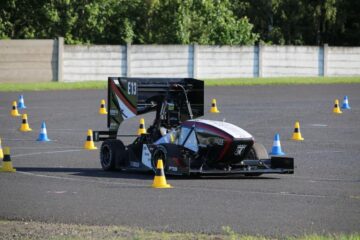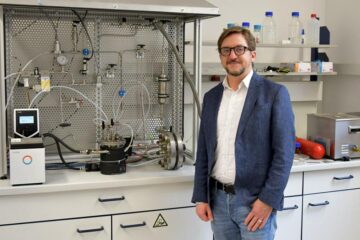Did life begin in a bubble?

Scientists in PEGG (Petroleum and Geochemistry Group) at the University of Plymouth have recently won two research grants totalling £114,000. The grants, awarded by the Natural Environment Research Council (NERC), are for research into the environmental effects of chemical discharges from oil rigs and – in a separate project – investigations into the chemical origins of life on earth.
Unfortunately, chemicals often get a bad press – but many are, of course, essential to life. Dr Simon Belt has been awarded £47,000 to study new, natural chemicals produced by microscopic algae, which may give a clue to the development of cellular life on Earth.
Over the past few years, scientists from Strasbourg University, France, have argued that in order for life on Earth to have developed from the `soup` of chemicals that many think are important, there must have been some way of encasing this chemical broth. „A sort of natural spontaneously-forming bubble – a bit like a long-lasting soap bubble in your washing up“ explained Dr Belt. Japanese workers carefully made some of these chemicals in the laboratory and found that those that formed the best bubbles were phosphates of so-called HBIs (short for highly branched isoprenoids: chemicals with a distinctive repeating unit of five carbon atoms).
PEGG scientists, Dr Simon Belt and Professor Steve Rowland, also found HBIs in microscopic plants or algae. However, the algal HBIs were not phosphates and would not form bubbles. The challenge before the Plymouth group now is to find the phosphates in algae as well. „By finding them we may have evidence for a new group of natural membrane-forming chemicals in these simple plants“, said Dr Belt. The NERC award will fund PEGG research assistant, Guillaume Massé, to try to isolate and identify the chemicals in a Plymouth laboratory. Encouragingly for the Plymouth chemists, the Japanese workers have offered to donate some of their chemicals for comparison.
Professor Steve Rowland and his PEGG team also won £67,000 to study the environmental effects of chemicals discharged from oil platforms into the North Sea. He commented: „People tend to think that oil is the most likely pollutant from an oil rig. But during the drilling process, oil and seawater mixed together emerge from the wells. This means that a lot of other chemicals then have to be added to separate the oil and water, and to stop the water from corroding the pipe work.“
After the oil has been separated off from the water, this so-called produced water is legally dumped back into the sea. Any chemicals remaining in the water also enter the environment. The amounts are huge: 244 million tonnes of produced water in the UK sector of the North Sea alone during the year 2000, according to Department of Trade and Industry figures. Norwegian scientists recently reported concerns over the effects of chemicals discharged from oil rigs on the reproduction of fish such as cod.
Previously, PEGG staff have received NERC funding to work with a Southampton company to develop a computer model of the fate of some of the discharged pollutants. Now Plymouth chemistry graduate, Paul McCormack, will be able to test the computer calculations against what is actually happening in samples taken from the sea water and bed around oil rigs.
This research is especially topical since new Pollution Prevention and Control regulations have recently come into force.
Media Contact
Alle Nachrichten aus der Kategorie: Förderungen Preise
Neueste Beiträge

Ideen für die Zukunft
TU Berlin präsentiert sich vom 22. bis 26. April 2024 mit neun Projekten auf der Hannover Messe 2024. Die HANNOVER MESSE gilt als die Weltleitmesse der Industrie. Ihr diesjähriger Schwerpunkt…

Peptide auf interstellarem Eis
Dass einfache Peptide auf kosmischen Staubkörnern entstehen können, wurde vom Forschungsteam um Dr. Serge Krasnokutski vom Astrophysikalischen Labor des Max-Planck-Instituts für Astronomie an der Universität Jena bereits gezeigt. Bisher ging…

Wasserstoff-Produktion in der heimischen Garage
Forschungsteam der Frankfurt UAS entwickelt Prototyp für Privathaushalte: Förderzusage vom Land Hessen für 2. Projektphase. Wasserstoff als Energieträger der Zukunft ist nicht frei verfügbar, sondern muss aufwendig hergestellt werden. Das…





















